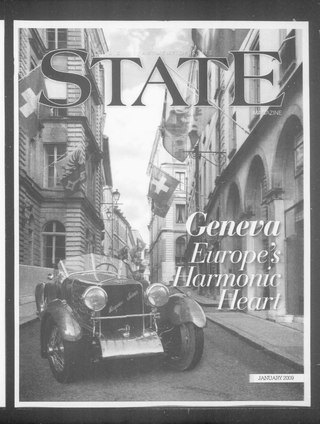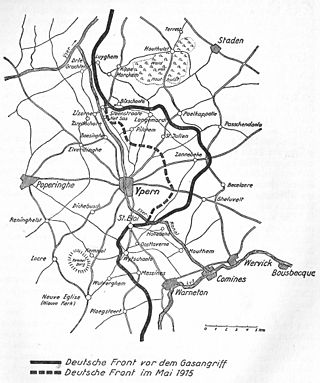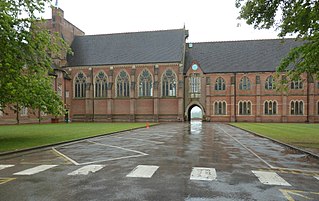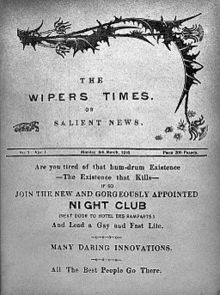
A magazine is a periodical publication, generally published on a regular schedule, containing a variety of content. They are generally financed by advertising, purchase price, prepaid subscriptions, or by a combination of the three.

"In Flanders Fields" is a war poem in the form of a rondeau, written during the First World War by Canadian physician Lieutenant-Colonel John McCrae. He was inspired to write it on May 3, 1915, after presiding over the funeral of friend and fellow soldier Lieutenant Alexis Helmer, who died in the Second Battle of Ypres. According to legend, fellow soldiers retrieved the poem after McCrae, initially dissatisfied with his work, discarded it. "In Flanders Fields" was first published on December 8 of that year in the London magazine Punch. Flanders Fields is a common English name of the World War I battlefields in Belgium and France.

Ian David Hislop is a British journalist, satirist, and television personality. He is the editor of the satirical magazine Private Eye, a position he has held since 1986. He has appeared on numerous radio and television programmes and has been the team captain on the BBC satirical quiz show Have I Got News for You since its inception in 1990. Hislop has been involved in numerous legal battles, as Private Eye has often been sued for libel over the years. Despite these challenges, Hislop has remained a key figure in British satire and journalism.

Ypres is a Belgian city and municipality in the province of West Flanders. Though the Dutch name Ieper is the official one, the city's French name Ypres is most commonly used in English. The municipality comprises the city of Ypres/Ieper and the villages of Boezinge, Brielen, Dikkebus, Elverdinge, Hollebeke, Sint-Jan, Vlamertinge, Voormezele, Zillebeke, and Zuidschote. Together, they are home to about 34,900 inhabitants.

Trench warfare is a type of land warfare using occupied lines largely comprising military trenches, in which combatants are well-protected from the enemy's small arms fire and are substantially sheltered from artillery. It became archetypically associated with World War I (1914–1918), when the Race to the Sea rapidly expanded trench use on the Western Front starting in September 1914.

The Ross rifle is a straight-pull bolt action rifle chambered in .303 British that was produced in Canada from 1903 until 1918.

The Christmas truce was a series of widespread unofficial ceasefires along the Western Front of the First World War around Christmas 1914.

During the First World War, the Second Battle of Ypres was fought from 22 April – 25 May 1915 for control of the tactically important high ground to the east and south of the Flemish town of Ypres in western Belgium. The First Battle of Ypres had been fought the previous autumn. The Second Battle of Ypres was the first mass use by Germany of poison gas on the Western Front.

The Wipers Times was a trench magazine that was published by British soldiers fighting in the Ypres Salient during the First World War.
The Gargoyle Humor Magazine or The Gargoyle is the official student-run humor magazine for the University of Michigan. It has been satirizing both local and national events for more than one hundred years. The magazine is part of the university's Student Publications, which also includes the campus newspaper, The Michigan Daily, as well as the yearbook, the Michiganensian.
The Ypres Salient, around Ypres, in Belgium, was the scene of several battles and a major part of the Western Front during World War I.

Zillebeke is a village in the Flemish province of West Flanders in Belgium. It is a former municipality which is now part of Ypres.

Nick Newman is a satirical British cartoonist and comedy scriptwriter.
Anzacs is a 1985 Australian five-part television miniseries set in World War I. The series follows the lives of a group of young Australian men who enlist in the 8th Battalion (Australia) of the First Australian Imperial Force in 1914, fighting first at Gallipoli in 1915, and then on the Western Front for the remainder of the war.

Military humor is humor based on stereotypes of military life. Military humor portrays a wide range of characters and situations in the armed forces. It comes in a wide array of cultures and tastes, making use of burlesque, cartoons, comic strips, double entendre, exaggeration, jokes, parody, gallows humor, pranks, ridicule and sarcasm.

Private Eye is a British fortnightly satirical and current affairs news magazine, founded in 1961. It is published in London and has been edited by Ian Hislop since 1986. The publication is widely recognised for its prominent criticism and lampooning of public figures. It is also known for its in-depth investigative journalism into under-reported scandals and cover-ups.

The Ypres League was a British World War I veterans and remembrance society. It was founded on 28 September 1920 to act as a brotherhood for veterans of the battles of the Ypres Salient, to remember those who died there, and to aid pilgrims traveling to the battlefields. It later became an incorporated society, based in London. It produced a quarterly newsletter and a guide book to Ypres, and provided a variety of services to its members, including specially designed membership certificates. It also worked to successfully erect a memorial church at Ypres. International branches were established, and the League celebrated its tenth anniversary in 1930. Publication of its newsletter continued well into the 1930s, and branches were still active in the 1940s.

The German phosgene attack of 19 December 1915 was the first use of phosgene gas against British troops by the German army. The gas attack took place at Wieltje, north-east of Ypres in Belgian Flanders on the Western Front in the First World War. German gas attacks on Allied troops had begun on 22 April 1915, during the Second Battle of Ypres using chlorine against French and Canadian units. The surprise led to the capture of much of the Ypres Salient, after which the effectiveness of gas as a weapon diminished, because the French and British introduced anti-gas measures and protective helmets. The German Nernst-Duisberg-Commission investigated the feasibility of adding the much more lethal phosgene to chlorine. Mixed chlorine and phosgene gas was used at the end of May 1915 against French troops and on Russian troops on the Eastern Front.
James Dutton is an English actor. He played Captain F. J. Roberts in the world premiere of The Wipers Times at the Watermill Theatre. Written by Ian Hislop and Nick Newman and produced by Academy Award winner David Parfitt the production transferred to the West End and opened at the Arts Theatre in 2017.















